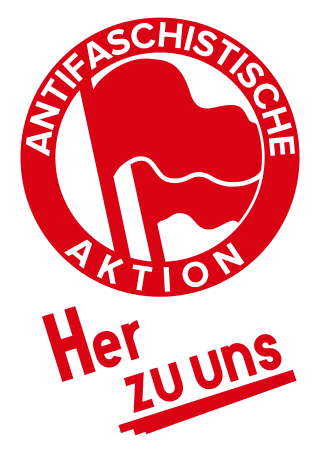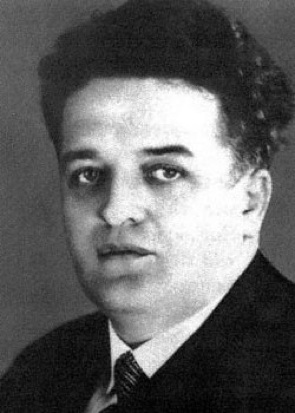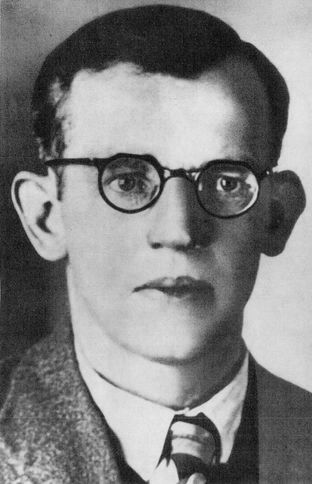Related Research Articles

The Communist Party of Germany was a major far-left political party in the Weimar Republic during the interwar period,an underground resistance movement in Nazi Germany,and a minor party in West Germany during the postwar period until it was banned by the Federal Constitutional Court in 1956.

Wilhelm Guddorf was a Belgian journalist,anti-Nazi and resistance fighter against the Third Reich. Guddorf was a leading member of a Berlin anti-fascist resistance group that was later called the Red Orchestra by the Abwehr. Guddorf was the editor of the Marxist-Communist Die Rote Fahne newspaper.

Antifaschistische Aktion was a militant anti-fascist organisation in the Weimar Republic started by members of the Communist Party of Germany (KPD) that existed from 1932 to 1933. It was primarily active as a KPD campaign during the July 1932 German federal election and the November 1932 German federal election and was described by the KPD as a "red united front under the leadership of the only anti-fascist party,the KPD."
Emil Carlebach was a German Landtag member,writer and journalist. He was born and died in Frankfurt am Main.
Oskar Müller was a German politician who was the first employment minister in Hesse after World War II.

The Iron Front was a German paramilitary organization in the Weimar Republic which consisted of social democrats,trade unionists,and democratic socialists. Its main goal was to defend social democracy against what was seen as anti-democratic,totalitarian ideologies on the far-right and far-left. The Iron Front chiefly opposed the Sturmabteilung (SA) wing of the Nazi Party and the Antifaschistische Aktion wing of the Communist Party of Germany. Formally independent,it was intimately associated with the Social Democratic Party of Germany (SPD). The Three Arrows,originally designed for the Iron Front,became a well-known social democratic symbol representing resistance against monarchism,Nazism,and communism during the parliamentary elections in November 1932. The Three Arrows were later adopted by the SPD itself.

Robert Uhrig was a German communist and resistance fighter against National Socialism.

The Association of Persecutees of the Nazi Regime –Federation of Antifascists (VVN-BdA) is a German political confederation founded in 1947 and based in Berlin. The VVN-BdA,formerly the VVN,emerged from victims' associations in Germany founded by political opponents to Nazism after the Second World War and the end of the Nazi rule in Germany.

The Buchenwald Resistance was a resistance group of prisoners at Buchenwald concentration camp. It involved Communists,Social Democrats,and people affiliated with other political parties,unaffiliated people,Christians,Jews,and Muslims. Because Buchenwald prisoners came from a number of countries,the Resistance was also international. Members tried to sabotage Nazi efforts where they could,worked to save the lives of child inmates,and in the last days of the camp,with many Nazis fleeing the approaching allied troops,tried to gain control of the camp itself. After liberation,the prisoners documented their experiences on paper and formed an international committee to look after the welfare of survivors.

Walter Bartel was a German communist resistance fighter,historian and university professor.

Walter Kraemer (Krämer) was a German politician of the German Communist Party (KPD) and member of the resistance against Nazism. From 1932/33,he was a deputy of the Prussian Landtag,was arrested in 1933 and murdered in 1941 in a sub-camp of the concentration camp Buchenwald in Goslar. He assisted prisoners with getting medical help,becoming known as the "Doctor of Buchenwald",for which he received from the State of Israel the posthumous title "Righteous among the Nations" in 2000.
Kurt Langendorf was a German participant in political resistance during the Nazi years. After 1945,he chose an academic career,becoming a university professor and economist,while also engaging in the Union of Persecutees of the Nazi Regime and its successor organisation.
Maria Wiedmaier was a German political activist (KPD) who engaged in anti-fascist resistance during the twelve Nazi years. She spent most of that time in a succession of state detention institutions,ending the war as a survivor from the Ravensbrück concentration camp.

Kurt Kresse was a German communist and resistance fighter against Nazism.

Alfred Kästner was a German communist and resistance fighter against Nazism.
Antifa is a political movement in Germany composed of multiple far-left,autonomous,militant groups and individuals who describe themselves as anti-fascist. According to the German Federal Office for the Protection of the Constitution and the Federal Agency for Civic Education,the use of the epithet fascist against opponents and the view of capitalism as a form of fascism are central to the movement. The antifa movement has existed in different eras and incarnations,dating back to Antifaschistische Aktion,from which the moniker antifa came. It was set up by the then-Stalinist Communist Party of Germany (KPD) during the late history of the Weimar Republic. After the forced dissolution in the wake of Machtergreifung in 1933,the movement went underground. In the postwar era,Antifaschistische Aktion inspired a variety of different movements,groups and individuals in Germany as well as other countries which widely adopted variants of its aesthetics and some of its tactics. Known as the wider antifa movement,the contemporary antifa groups have no direct organisational connection to Antifaschistische Aktion.
Marxist Workers' School (MASCH) was an educational institute founded in the winter of 1925 in Berlin,by the Berlin city office of the Communist Party of Germany (KPD). Its function was to enable workers to learn the basics of proletarian life and struggle,to teach the basic tenets of Marxism. It was co-founded by Hermann Duncker,Johann Lorenz Schmidt and Eduard Alexander. Hermann Duncker became the director of school. The school became very successful and by 1930,it had 4000 students in 200 courses,which prompted KPD officials to build 30 other schools in German cities e.g. Dresden and Chemnitz. After the seizure of power by the National Socialists in the spring of 1933,the schools were closed.
Albert Kuntz was a German goldsmith,soldier,communist and concentration camp victim. A soldier in the First World War,Kuntz rose to become an elected representative of the German Communist Party in Berlin's Prussian Landtag. In 1933 he was arrested by the Gestapo,and sent to a succession of prisons and concentration camps. He died in January 1945 at the Mittelbau-Dora concentration camp,where he had been organizing the sabotage of the V-2 rocket production line. Following his death,he was revered as an anti-fascist hero in East Germany.

Walter Husemann was a German communist and resistance fighter against the Nazi regime. As a young man,Husemann trained an industrial toolmaker,before training as a journalist. He became interested in politics and joined the Communist Party of Germany (KPD). With the arrival of the Nazis in 1933,he became a resistance fighter and through his wife,the actor Marta Husemann,he became associated with an anti-fascist resistance group around Harro Schulze-Boysen and Arvid Harnack that was later called the Red Orchestra by the Gestapo. Along with John Sieg whom he met in the KPD and Fritz Lange,Martin Weise and Herbert Grasse he wrote and published the resistance magazine,The Internal Front Die Innere Front.
Theodor Neubauer was a German communist politician,educator,essayist,historian and anti-Nazi resistance fighter.
References
- ↑ PDS/Offene Liste Düren, Informationen zu Kurt Bachmann, (in German). Düren: Stadtarchiv Düren. 2004-01-15.
- ↑ Kraushaar, Luise (1970). Deutsche Widerstandskämpfer 1933 bis 1945[German resistance fighters 1933 to 1945] (in German). Vol. 1. Berlin: Dietz Verlag. pp. 531ff.
- ↑ Röder, Werner; Strauss, Herbert (1980). Biographisches Handbuch der deutschsprachigen Emigration nach 1933[Biographical Handbook of German-speaking Emigration after 1933] (in German). Vol. 1. Munich: K. G. Saur Verlag. p. 399.
- ↑ "NRW-Finanzämter drohen der VVN-BdA mit Entzug der Gemeinnützigkeit" [NRW tax offices threaten to revoke VVN-BdA's non-profit status]. International Federation of Resistance Fighters – Association of Anti-Fascists (in German). 2019-02-27. Retrieved 2024-10-14.
- ↑ Hochmuth, Peter; Hoffman, Gerhard (2007). Buchenwald, ich kann dich nicht vergessen[Buchenwald, I can't forget you.] (in German). Berlin: Dietz Verlag. ISBN 978-3320021009.
- 1 2 "Russian award to Davis". The Spokesman-Review . 1979-05-01. p. 2. Retrieved 2024-10-14.
- ↑ Yearbook of the Great Soviet Encyclopedia (in Russian). Moscow: Sovetskaya Enciklopediya. 1979. p. 599.
- ↑ Bachmann, Kurt (1983). 1933: Texte, Fotos, Chronik (in German). Frankfurt: Verlag Marxistische Blätter. ISBN 978-3880126756.